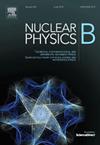Deep learning Calabi-Yau four folds with hybrid and recurrent neural network architectures
IF 2.5
3区 物理与天体物理
Q2 PHYSICS, PARTICLES & FIELDS
引用次数: 0
Abstract
In this work, we report the results of applying deep learning based on hybrid convolutional-recurrent and purely recurrent neural network architectures to the dataset of almost one million complete intersection Calabi-Yau four-folds (CICY4) to machine-learn their four Hodge numbers , , , . In particular, we explored and experimented with twelve different neural network models, nine of which are convolutional-recurrent (CNN-RNN) hybrids with the RNN unit being either GRU (Gated Recurrent Unit) or Long Short Term Memory (LSTM). The remaining four models are purely recurrent neural networks based on LSTM. In terms of the , , and prediction accuracies, at 72% training ratio, our best performing individual model is CNN-LSTM-400, a hybrid CNN-LSTM with the LSTM hidden size of 400, which obtained 99.74%, 98.07%, 95.19%, 81.01%, our second best performing individual model is LSTM-448, an LSTM-based model with the hidden size of 448, which obtained 99.74%, 97.51%, 94.24%, and 78.63%. These results were improved by forming ensembles of the top two, three or even four models. Our best ensemble, consisting of the top four models, achieved the accuracies of 99.84%, 98.71%, 96.26%, 85.03%. At 80% training ratio, the top two performing models LSTM-448 and LSTM-424 are both LSTM-based with the hidden sizes of 448 and 424. Compared with the 72% training ratio, there is a significant improvement of accuracies, which reached 99.85%, 98.66%, 96.26%, 84.77% for the best individual model and 99.90%, 99.03%, 97.97%, 87.34% for the best ensemble. By nature a proof of concept, the results of this work conclusively established the utility of RNN-based architectures and demonstrated their effective performances compared to the well-explored purely CNN-based architectures in the problem of deep learning Calabi Yau manifolds.
求助全文
约1分钟内获得全文
求助全文
来源期刊

Nuclear Physics B
物理-物理:粒子与场物理
CiteScore
5.50
自引率
7.10%
发文量
302
审稿时长
1 months
期刊介绍:
Nuclear Physics B focuses on the domain of high energy physics, quantum field theory, statistical systems, and mathematical physics, and includes four main sections: high energy physics - phenomenology, high energy physics - theory, high energy physics - experiment, and quantum field theory, statistical systems, and mathematical physics. The emphasis is on original research papers (Frontiers Articles or Full Length Articles), but Review Articles are also welcome.
 求助内容:
求助内容: 应助结果提醒方式:
应助结果提醒方式:


